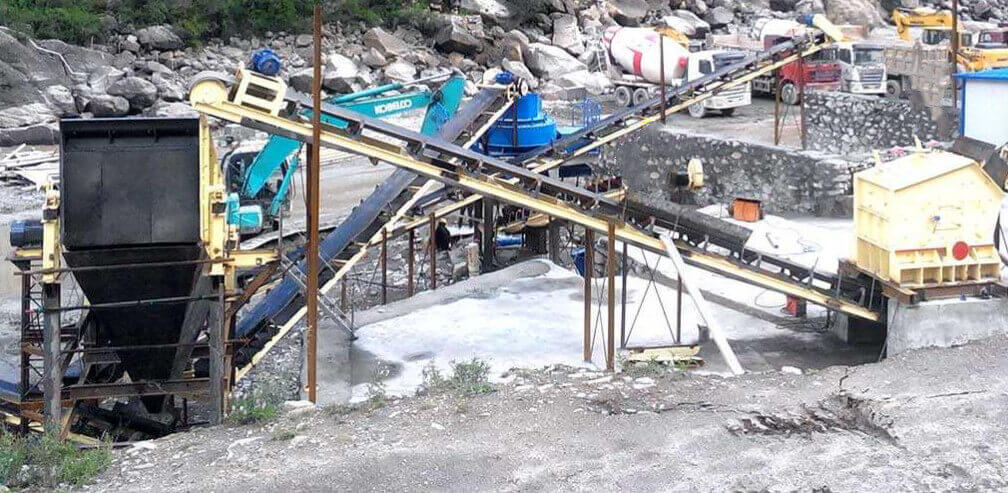Limestone is a kind of stone widely found in nature. Its main component is calcium carbonate. Limestone can be directly processed into stone using crushing equipment and fired into quicklime. Quicklime absorbs moisture or adds water to become hydrated lime. The main component of hydrated lime is calcium hydroxide. The hydrated lime is prepared into lime slurry, lime paste, etc., as coating materials and brick adhesives.
Limestone Uses
Limestone is a versatile rock with various uses:
- Construction Material: Limestone is a popular material used to construct buildings, roads, and bridges. It is often cut into blocks or slabs for these purposes.
- Calcium Source: Limestone is a significant source of calcium, used in cement and mortar production and as a soil conditioner in agriculture.
- Neutralizing Agent: Crushed limestone is used to neutralize acidic soils, helping to improve soil fertility for agriculture.
- Industrial Uses: Limestone is used in various industrial processes. It can be a raw material in producing lime (calcium oxide) and used in manufacturing steel, glass, and other materials.
- Decorative Stone: Limestone is also used for decorative purposes in landscaping and architecture. It can be polished for a smooth surface or left in its natural state for a more rugged appearance.
- Water Treatment: Limestone is used in water treatment processes to adjust the pH levels and remove impurities from water.
- Caves and Karst Landscapes: Many caves and karst landscapes are formed in limestone regions through rock dissolution by water.
It’s worth noting that limestone can come in different colors, ranging from white and gray to yellow, brown, and even black, depending on the impurities present. The characteristics of limestone can vary, and different types of limestone may have distinct uses based on their composition and properties.
As limestone processing sand and gravel aggregate prices continue to rise and the market improves, limestone-crushing line equipment is becoming increasingly popular. So, how do you choose from so many crushers on the market? What equipment is best for crushing limestone?
Limestone Crushing Equipment
Based on the characteristics of limestone, here are several machines recommended to you: jaw crusher, impact crusher, screening, feeding, and other supporting equipment.
Primary crushing – jaw crusher
Large pieces of limestone need to be transported into the jaw crusher by the feeder for preliminary crushing and the crushed materials will be transported to the next stage.
Secondary crushing – impact crusher
The conveyor sends the coarsely crushed limestone to the impact crusher for further crushing. The impact crusher has good wear resistance, good discharge particle size, low fine materials, and low stone powder content.
Screening – vibrating screen
After impact crushing, the finely crushed stone material enters the vibrating screen to screen out stone specifications that meet production needs.
Return material to crush
The limestone that does not meet the specifications screened out by the screening machine must be returned to the impact crusher for crushing again until it meets the requirements of the finished product specifications.
Limestone Crushing Production Line
The limestone crushing production line mainly consists of a vibrating feeder, jaw crusher, impact crusher, vibrating screen, belt conveyor, centralized electronic control, and other equipment. To meet the different processing needs of customers, it can be equipped with a cone crusher, dust collector Equipment, etc. The jaw crusher performs coarse crushing of sand and gravel, and the feeding force is large. The impact crusher finely crushes the sand and gravel, with a small size and low energy consumption. The cone crusher performs fine crushing of high hardness, strong crushing force, and high safety factor. Sand-making machine processing capacity Strong, uniform grain shape.
Feeding stage
Vibrating feeders, which can feed materials into the crusher evenly, quantitatively, and continuously, are commonly used.
Crushing stage
The process involves several crushers, mainly coarse crushing, and medium and fine crushing equipment. Jaw crushers are mainly used for coarse crushing, and cone crushers and impact crushers are mainly used for medium and fine crushing equipment. They can process hard rocks, such as granite, and soft rocks, such as limestone.
Sand-making stage
The sand-making stage is generally used after the crushing stage. A vertical shaft impact crusher is commonly used, which can further finely crush and shape the stones produced by the crushing process to produce machine-made sand specifications of less than 5mm.
Screening stage
The screening operation is an auxiliary process. The finished sand and gravel materials from crushing or sand-making processing are screened through the vibrating screen to obtain the finished product specifications and gradation.
Conveying stage
Conveying and screening are also auxiliary processes. A belt conveyor is an ideal and efficient continuous conveying equipment with continuous conveying, reliability, convenience, long conveying distance, low energy consumption, large conveying capacity, and green and environmental protection.
Sand washing and dust removal stage
Dust removal equipment and sand washing equipment are generally configured as needed. Under the requirements of environmental protection, dust pollution is minimized. The sand washing machine is generally equipped with a wheel sand washing machine with high output, simple operation, and convenient operation.
LATEST PRODUCTS
Twin Screw Feeder
【Feeding Capacity】 10-160 t/h【Power】 2.2-…
Tubular Screw Conveyor
【Capacity】6-50 m3/h【Procesible Material】 …
Heavy Plate Feeder
Capacity: 100-240 m3/h Power: 15-45 kW Speed: 0…










